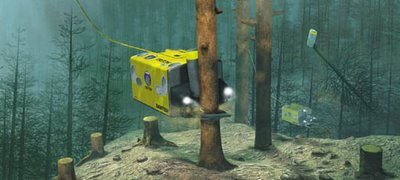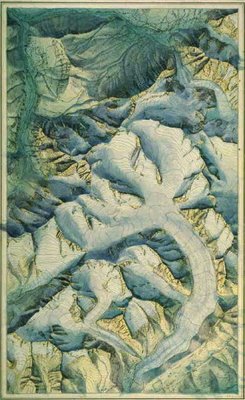
Elliot Spitzer has closed a deal to stop sewage dumping in the Bronx River:
Four Westchester municipalities - Scarsdale, White Plains, Mount Vernon and Greenburgh - agreed to stop discharging sewage into the Bronx River by May 1, 2007, under a Nov. 28 agreement reached with the attorney general and the state Department of Environmental Conservation.Better late than never, though I can't help speculating on how quickly the problem would've been solved if the effluent had been traveling from the South Bronx to Scarsdale.
Scrubbers will be installed at the Keystone Power Plant in Pennsylvania, which is one of the dirtiest in the country:
After the scrubbers are installed the plant is expected to cut 170,000 tons of sulfur dioxide and 1,600 tons of particulate matter from its emissions annually. The numbers represent about 98 percent of the plant's emissions.Brazil has protected a large chunk of the Amazon rain forest:
"If any tropical rain forest on Earth remains intact a century from now, it will be this portion of northern Amazonia," Conservation International President Russell Mittermeier said.Ummm...hooray, I guess.
You'll also be excited to know that SUV sales are down by 15 percent in the UK. And that you may soon be able to buy a computer that's powered by a methanol fuel cell.
I'm given to understand that trees have an economic value as lumber. That being the case, you might imagine that before governments drown landscapes to create reservoirs, they'd cut down the trees. They generally don't, though, which is one reason why - as Inhabitat notes - there are "over 5 billion linear board feet of usable timber submerged in the forests of British Columbia’s lakes and reservoirs." A remotely controlled underwater robot called the Sawfish allows these underwater forests to be harvested. I think this illustration communicates the process pretty well:
 Just for fun, you might want to look at this list of drowned towns. I'm also fascinated to learn that the phenomenon has generated its own subgenre of crime fiction, called reservoir noir. The author of one such book claims that there are still pecan orchards under Austin's Lake Travis.
Just for fun, you might want to look at this list of drowned towns. I'm also fascinated to learn that the phenomenon has generated its own subgenre of crime fiction, called reservoir noir. The author of one such book claims that there are still pecan orchards under Austin's Lake Travis.In a tangentially related story, BushCo's demented oil-exploration policies have led to myriad archaeological discoveries in the Western states:
Wyoming State Historic Preservation Officer Sara Needles said her 13-person office can barely fathom the wealth of the archeological findings.In other archaeological news, the UN has approved a draft resolution requiring the repatriation of antiquities:
The office doesn't even have the time to nominate the most significant sites for the National Register, said Needles and her deputy, Mary Hopkins. Still, the very act of designating them historic or prehistoric provides legal protection, they said.
“The illegal trade of antiquities is in the same category as the illegal trade of weapons, narcotics and people. It amounts to a form of organized crime that is directly related to mobsters and money laundering,” the minister said while addressing a plenary session of the UN General Assembly in New York.A Canadian firm is apparently doing wonders with e-waste:
At the 24,600 square-metre plant owned by Noranda Recycling, much of the raw material is salvaged onsite. Even the dust produced by ground-up gadgets is sucked up and repurposed.Read the article in full; it does a good job of describing business as usual in the e-waste trade.
The company bills itself the country's most advanced e-waste recycler. It claims not to ship scraps offshore or to landfills. When Noranda hires subcontractors to dispose of hazardous parts, it monitors their practices and attempts to track the raw materials to their final resting places. "I've physically audited every one of our recyclers," says Cindy Thomas Coutts, who directs Noranda's Brampton operation.
British researchers are working on a Malaria Atlas Project:
Simon Hay and Robert Snow (Kenya Medical Research Institute and University of Oxford), say that it has been almost 40 years since the last global map of malaria endemicity was constructed, and that "there have been no recent efforts to construct a credible evidence-based global malaria map."Pruned discusses biocidal buildings:
As interesting as the image of viruses getting speared and eviscerated may sound, what is even more interesting is the fact that this “experimental substance, which can be applied like paint, might complement other germ control methods used in public spaces such as hospitals and airplanes.” So if the oft-forecasted influenza pandemic should come, those same public spaces will function more as biohazard filters instead of as urban vectors for the virus.Low doses of RU-486 seem to shrink uterine fibroids:
Leiomyoma, the medical term for uterine fibroids, affects roughly half of all women aged 35 to 49. The non-cancerous tumors cause iron-deficiency anemia due to excessive menstrual bleeding, and deeply impact the quality of life for women who have this condition. Thousands of women annually opt for hysterectomies or have the tumors removed surgically because no other medical treatment has been proven effective, the study said.The photo at top is from the private collection of Angela at (what is this?). I hereby command you to check out the other photos she's posted.
“With no approved treatment for symptomatic fibroids, this study and its findings are very significant,” said corresponding author Kevin Fiscella, M.D., M.P.H., of the Department of Family Medicine Research Program at the University of Rochester Medical Center. “Interestingly, this is the same drug that was recently shown to prevent breast cancer in a rat model. Federal funding for research related to mifepristone should be given a high priority.”
Afterwards, you can take a brief video tour of the Plzen Historical Underground. I also recommend A I R 33's photosets on Flickr (especially HDR and her night views of Toronto and environs).

Coudal links to a collection of Strange Soviet Buildings. And BibliOdyssey almost made me start hyperventilating with its latest grab-bag of illustrations, which includes this remarkable surrealist artifact:

Last, click here to view work by the Swiss cartographer Eduard Imhof, including this glorious 1929 image of the Aletsch Glacier, which I could stare at all day (click to enlarge):

2 comments:
Good for Spitzer. Would be nice to see a more consistent environmental approach in NY.
nice post, thx
Post a Comment